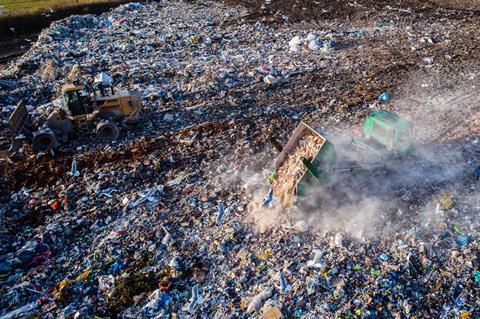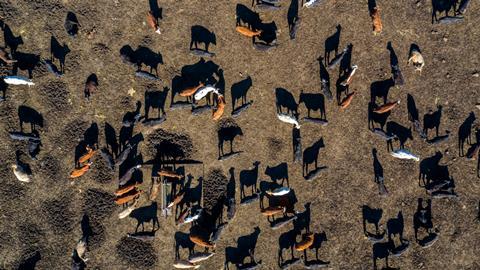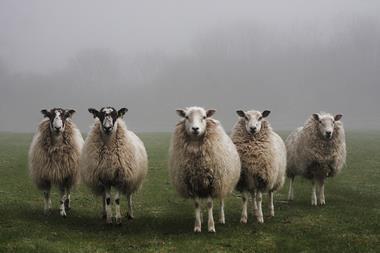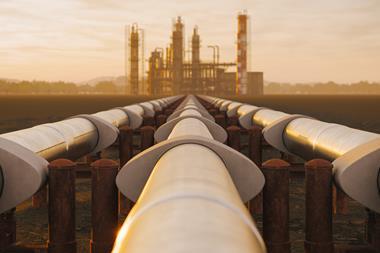Bárbara Pinho looks at the problem of methane emissions and how scientists are trying to prevent them
The 24 chambers line up perfectly in a lab that looks like it should be in a sci-fi film. An intertwined network of tubes and cables connect each chamber to a central device that measures gases, humidity, pressure and temperature. It may look a bit unpleasant, but the occasional ‘baa’ echoing through the halls brings a bit of joy. After all, the main subjects of this lab are sheep.
At the Grasslands Research Centre in the New Zealand city of Palmerston North, Neil Wedlock and his colleagues have studied hundreds of sheep for years. They’ve built chambers where they place each animal, carefully measuring how much gas is emitted by sheep and cattle while they’re eating. They want to understand these emissions and find molecular ways of reducing them, and even though sheep emit a diverse array of gases, they focus on one in particular: methane.
The two climate problems
In 1997, when the United Nations adopted the Kyoto Protocol, methane was one of seven greenhouse gases listed as part of the commitment to reduce their emissions. But the focus since then has been almost exclusively on carbon dioxide.

‘When policymakers and researchers started to work with strategies to fight climate change, they adopted a set of metrics that related to 100-year impact. But because methane time in the atmosphere is roughly a decade, these metrics caused a misarrangement in policy action,’ explains Steven Hamburg, chief scientist at the Environmental Defense Fund in the US.
Methane doesn’t stay for long in the atmosphere. Its decade-long residence time starkly contrasts with carbon dioxide’s century-long span. And methane concentration levels are far lower than those of carbon dioxide: if the atmosphere were a swimming pool, there would be about two cups worth of methane in there, compared to a whopping 442 cups of carbon dioxide. So while it’s understandable the world has paid closer attention to carbon dioxide, methane isn’t innocuous. In a 20 year timescale, it’s 80 times more powerful in warming the planet than carbon dioxide since it traps heat more efficiently. It’s thought that at least 25% of the warming we are now experiencing is caused by anthropogenic emissions of this short-lived gas. And even after a decade, methane’s impact continues. Over the years, it reacts with ozone to form water and carbon dioxide, with the latter staying in the atmosphere and contributing to climate change for years on end.
The Kyoto protocol has since been rectified and updated, and methane is increasingly seen as a greenhouse gas deserving of everyone’s attention. At the Cop26 climate summit in November 2021, world leaders launched the Global Methane Pledge, an initiative to lower methane emissions in the coming years to limit warming to 1.5°C. Over 100 countries joined the pledge, including the UK and the US, committing to reducing methane emissions by at least 30% until 2030. The nations will also improve how they measure and quantify methane emissions. This (almost) global effort could bring visible results rather quickly.
Reducing methane emissions buys us the time to do the hard work of reducing CO2 emissions
‘We can reduce methane emissions in half, and that will have a dramatic impact on reducing the rate of warming and the total amount of warming we experience over the next 30 years,’ Hamburg says. To him, we are currently experiencing two different climate problems: one of carbon dioxide and one of methane. Methane is a near-term problem and carbon dioxide is a long-term one. Both require solutions, albeit very different ones. ’In the near term, if we want to reduce the damages, methane is the most important thing we can do. But in the long term, CO2 is the most important. Both things can be true at the same time,’ Hamburg adds.
Hamburg explains that lowering carbon dioxide is a daunting task; it interferes with humanity’s entire energy economy and demands great effort. Methane, on the other hand, is simpler to tackle. The technology to make significant methane reductions already exists, and it’s cost-effective. As long as it doesn’t put decarbonising society on hold, then focusing on this short-lived gas is a crucial step. ‘[Lowering methane emissions] buys us the time to do the hard work,’ Hamburg explains. ‘But we have to be careful; it’s not hitting pause.’
The emitters
Methane has a broad spectrum of emitters, and not all are human. Bacteria in wetlands, for example, emit large quantities of the gas. Methane is also released when cows burp, when microorganisms decompose rubbish in landfills and when natural gas is produced. There’s a mixture between anthropogenic and naturally occurring emissions. Yet, evidence points that humans’ actions have skyrocketed emissions for decades now. According to the latest IPCC report, ever since 2007, concentrations of methane have steadily increased, with researchers attributing it to emissions from major sources like fossil fuel exploitation, waste, and livestock (see Measuring methane emissions is crucial to cutting them).
’We waste about 30 to 40% of all food production. Imagine that across the system, all of that waste emits methane,’ says Chad Frischmann, lead researcher at Project Drawdown, an initiative where researchers assess the best solutions to tackle climate change.
The rubbish and waste we make every day is a top source of methane. While sitting in landfills, food scraps and other organic waste decompose, producing gas that’s rich in methane, carbon dioxide and other compounds. Commonly known as landfill gas, it amounts to a significant percentage of methane emissions worldwide. In 2019, landfills in the US alone emitted the same greenhouse gas as 12 million homes, and the numbers are expected to increase. Three years from now, researchers predict that landfills will account for 8–10% of all anthropogenic greenhouse gas emissions. Methane-observing satellites like Tropomi, an instrument currently in orbit aboard the European Space Agency’s Sentinel 5 satellite, keeps finding landfills that emit loads of methane. In August 2021, using Tropomi data and other satellites’ information, scientists found landfill sites emitting 8800kg of methane per hour close to Madrid’s city centre. Yet, while what comes from everyone’s bins plays a crucial role in how much waste goes to landfills, the blame is shared with other players in the food supply chain game.
We waste about 30–40% of all food production. All of that waste emits methane
‘Waste comes all across the supply chain, from production to harvesting, packaging, processing, distribution and market consumption,’ Frischmann says. Our food is grown in around 570 million farms globally, processed in thousands of facilities, and transported in a complex network of ships, planes and lorries. Working around a supply chain that’s so vast takes ingenuity and time. Yet to Frischmann, the leading solution is still up to consumers. ‘In high-income countries, most of the food gets wasted at the end of the supply chain by consumers,’ he says. ‘Most people overconsume, over-purchase, and then they throw it into the landfill.’ He explains that how consumers make choices in grocery stores and restaurants dictates how much waste the world generates. But while the food supply chain is fixed (and that will probably take some time to change), there are solutions to work around the methane emitted by landfills. Instead of hampering emissions, a solution could be to make them useful.
A smart use of landfills
Natural gas is a convenient fuel, so finding ways to put landfill methane to use could kill two birds with one stone: on the one hand, it would lower emissions from landfills. On the other, natural gas could provide power. Of the more than 500 landfills in the UK, ten are already equipped with landfill gas recovery systems. The way to do this is rather simple in principle. The rubbish that goes into landfills is buried into sections called cells and then covered by layers of soil or other materials. The final cover is thicker and made of sand, clay, soil and grass. This is to avoid emissions of methane and other gases into the atmosphere. Via a network of pipes and vacuum pumps, methane is collected from the landfill and taken to a processing facility. Here, it is treated depending on the final outcome desired for the gas. Some facilities purify methane, so it reaches natural gas standards. Others either flare the methane (converting it into carbon dioxide and releasing it into the atmosphere) or generate electricity. Gas yields depend on the size and nature of landfills, but a large modern landfill could make usable fuel for 15 to 30 years.

Another strategy to capture methane before it goes into the atmosphere is by using methane digesters. Methane digesters are large systems that turn organic matter’s methane into valuable substrates. Either organic matter or cattle manure is accumulated in large tanks where microbes produce biogas, which could serve as fuel after being burned, and the so-called digestate, a solid that could be used as a fertiliser.
‘Organic materials can go into that [methane digester] system, generating methane, and what ends up happening is you can burn off that methane to produce electricity. For these large scale operations, it can power the facility rather than drawing on the grid,’ Frischmann explains.
This strategy has increasingly more fans in countries like Germany, where there are already 8000 methane digester systems implemented. Though more systems are used to take up cattle manure than the waste coming from landfills, methane digesters can turn any organic matter to use while avoiding methane emissions.

Of course, isn’t a silver bullet: burning biogas to produce electricity releases carbon dioxide. Still, it’s a step towards mitigating the short-term climate problem of methane. In the meantime, instead of looking at how humans waste much of what they could eat, other researchers are taking a look at the diets of animals like cows and sheep.
Jabs for sheep
In New Zealand, Wedlock’s work looks to lower methane emissions right from the beginning: cattle’s digestive systems. Cows and sheep are just some of the many animals in the world that ruminate. These creatures digest their food for hours, chewing and re-chewing grass that goes in and out of their four-chambered stomach. The rumen, the first section of their stomach, is home to a complex system of microorganisms and is where a simple meal becomes a climate change problem. Bacteria in the rumen called methanogens take up complex carbohydrates and perform methanogenesis, an anaerobic respiration process. Carbon dioxide is used as a terminal electron acceptor, and H2 is oxidised to H+ while CO2 is reduced to CH4. This molecular pathway in a cow’s stomach produces around 200 litres of methane in a day. With 1.4 billion cattle in the world, the maths add up pretty quickly, making livestock production the largest anthropogenic source in the global methane budget.
A cow’s stomach produces 200 litres of methane a day
Wedlock and his team have been working on a vaccine to stop methanogenesis. According to him, the ideal vaccine would produce antibodies that would act against components of methanogens and thus interrupt the chemical production of methane. But reaching methanogens isn’t that easy; they are, after all, a mere 3% of the complex microbiome in the rumen. So the team looked at saliva instead.
‘These animals produce copious quantities of saliva every day; a sheep can produce 10 to 16 litres a day, and most of the saliva is swallowed,’ Wedlock explains. ‘Once you generate antibodies in the saliva against the methanogens […] it is a perfect vehicle to deliver the antibodies into the rumen.’
In recent trials, after developing a prototype of the vaccine and administering it to sheep, Wedlock and his team placed the animals into the chambers of their research centre and compared their emissions to those of unvaccinated animals. So far, the team hasn’t seen any relevant differences, but Wedlock is hopeful for the future. ‘We’ve got an experiment lined up in a couple of months where we’re going to try an experimental vaccine and put them [sheep] through chambers again. This might be the big breakthrough, but I can’t predict that; I can only hope for it,’ he says.
The hurdles to overcome go beyond biology. After all, a tool is only helpful if it finds a place in the immense agricultural supply chain. ‘A Covid-19 vaccine for a human can be quite expensive; governments will pay for it. But a farm is not going to pay for something unless it’s cheap,’ he explains. ‘You can’t produce something that’s a $100 dose. It’s got to be either one dollar or two, maybe less.’
Then, there’s the challenge of public perception. While Wedlock thinks the anti-vax movement wouldn’t be too worried about livestock as they are with the Covid-19 jab, he’s still cautious. ‘Public perception is something you have to watch,’ he adds. ‘That can kill a solution.’
On the other side of the Pacific Ocean, US researchers want to stop methanogenesis in cattle. Instead of working on vaccines, however, Ermias Kebreab, a professor of sustainable animal agriculture at the University of California, Davis, has been looking at supplements.
Bring in the supplements
During the 2010s, studies in Petri dishes showed that the red macroalgae (seaweed) Asparagopsis taxiformis lowered ruminant methane production by up to 99%. With this information, Kebreab and his colleagues went on to see if adding this type of seaweed as a feed supplement to cattle’s diet would decrease methanogenesis and thus reduce emissions. In their latest work, results were promising.
‘Using a very small amount of seaweed would get you a methane reduction up to 80%. In some cases, it was even up to 98%,’ he explains. ‘That, to me, is really incredible. If you are able to reduce methane by that much, then I think we have a very good solution to be able to sustainably produce food.’
In the study, Kebreab looked at three groups of Angus–Hereford cross beef steers (neutered male cattle). One group took no supplements, the other took seaweed as 25% of their diet, and the third group was given a diet of half seaweed and half concentrate feed. They fed the animals for five months, measuring the emissions every three weeks. Unlike Wedlock’s chambers in New Zealand, Kebreab used the GreenFed system. This open-air device measures the gases emitted by animals while they’re busy eating a treat. The supplements reduced methane to impressively low levels without interfering with beef quality standards.
A very small amount of seaweed would get you a methane reduction up to 80%
The key to the results lies in the anti-methanogenic activity of some red seaweeds. The supplements produced with Asparagopsis taxiformis have an active ingredient, bromoform (CHBr3). In the rumen, bromoform interferes with an enzyme essential to complete methanogenesis, methyl coenzyme reductase (MCR). To properly work, MCR’s nickel cofactor needs to be oxidatised to continue the methane-producing reaction. Once it gets to the rumen, bromoform continuously reduces nickel, inhibiting MCR and thus inhibiting methanogenesis.
Seaweed turns out to be an exciting tool to lower methane emissions. Still, if every farm in the world wants a bit, could macroalgae producers keep up with the demand? Or would it create yet another problem in the food supply chain? To Kebreab, there’s little doubt. He explains that growing seaweed in the ocean doesn’t require any fertiliser or fresh water. Plus, it naturally removes carbon dioxide from the ocean, so this could be a win–win situation. ‘Companies are working hard to scale up, and that could present an issue. But of course, we have to do a life cycle assessment and see how much energy is required to grow seaweed,’ he adds.
The supplement is not yet on the market because it still awaits approval from regulatory bodies. And that takes time, sometimes too much. ‘With the FDA, it’s very difficult to know [when the supplements reach the market]. If they think that this is urgent and important, then they can do it within a few months. But otherwise, it might take years,’ Kebreab explains.
While the Californian supplement waits for the green light, other supplements are one step ahead and closer to reaching farms worldwide. In Europe, Dutch company DSM created Bovaer, a feed additive that targets the same enzyme as red seaweed. The main active ingredient, 3-nitrooxypropanol, inactivates the enzyme at micromolar concentrations by oxidising its active site. Bovaer has been approved for commercialisation in Brazil and Chile, and in late 2021, the European Food Safety Authority provided a positive assessment of the product, bringing it one step closer to European markets.
The short-lived gas that has been ignored by policymakers for so long is now in dozens of headlines and politicians’ speeches. The work scientists and researchers worldwide are doing is timely and, more than ever, necessary if humanity is to prevent the worst from happening. ‘I’m a forest ecologist. I’ve seen first-hand the impacts of climate change on forests,’ Hamburg says. ‘This is one of the biggest opportunities to slow the rate of warming in the next couple of decades, and we need to take advantage of it.’
Bárbara Pinho is a science writer based in Porto, Portugal













No comments yet